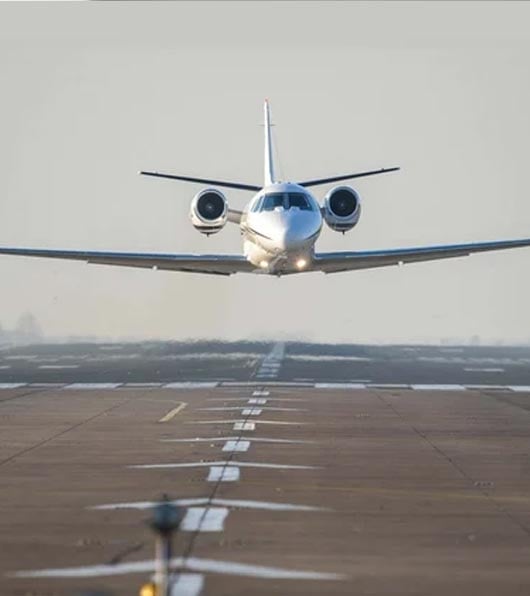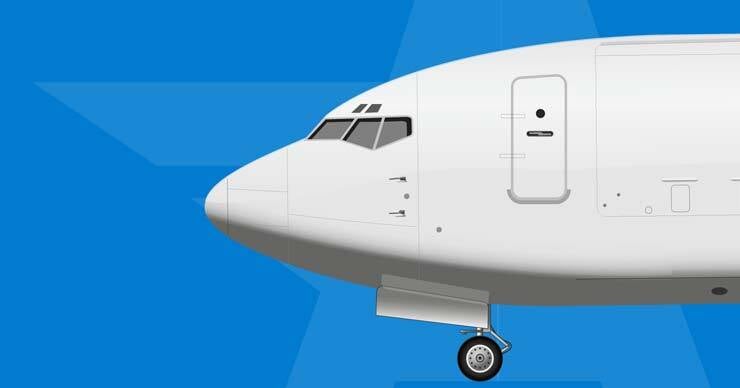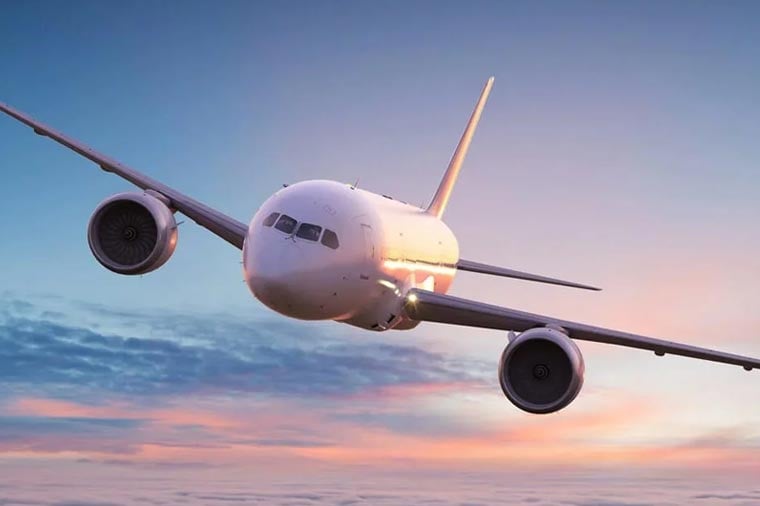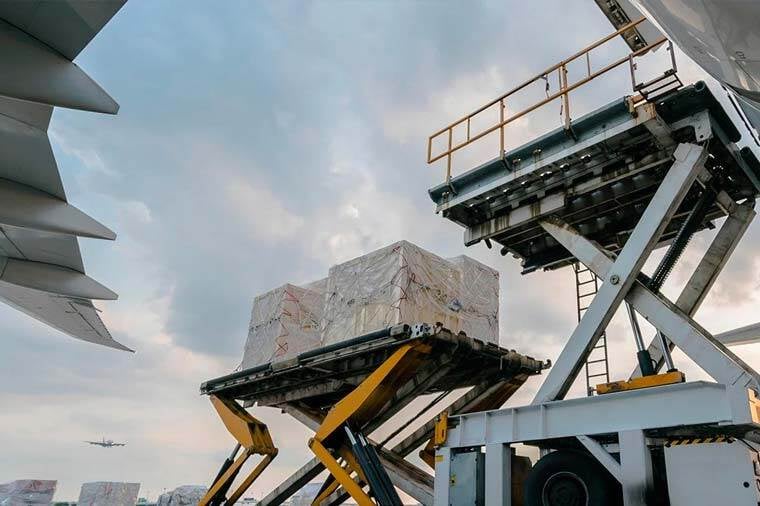Freighter aircraft unlock shipping options that standard ocean or parcel services simply can’t match. When every hour counts, these dedicated cargo jets become mission-critical. High-value electronics and urgent medical supplies can depart factory zones in China and reach U.S. gateways quickly, far outpacing any alternative mode. This time-critical air freight service backstops tight production schedules and safeguards time-sensitive cargo all the way to its final destination.
Air Freight from China
When shipping between China and USA it's important to work with the right logistics partner. Founded nearly two decades ago with a singular focus on time-critical logistics, AirFreight.com specializes in moving urgent expedited freight by both air and ground shipping.
Delivering premium China-to-USA logistics solutions—specialists in air freight, bespoke air charters, and time-critical ground expedites.
Air cargo between China and the United States is a critical artery of global trade, carrying high-value, time-sensitive goods rapidly across the Pacific. Trans-Pacific air freight between the United States and China remains one of the world’s busiest cargo corridors.
Over the years, thousands of manufacturers, e-commerce firms, and healthcare providers have relied on our expedited air freight services to bridge last-minute gaps in their supply chains.

Why work with AirFreight.com?
A SINGLE POINT OF CONTACT
From start to finish, you'll have a dedicated expediter guiding your shipment—no frustrating call centers or wasted time due to miscommunication.
24/7 Coverage, 365 Days a Year
Our tracking technology keeps you connected with your shipment every step of the way. Because it's monitored by our expeditors, you’ll always know exactly where your freight is.
Expert Expediters
We meticulously analyze ground and air traffic patterns, anticipate weather disruptions, and account for potential flight delays, ensuring that nothing interferes with your deadline.

Air Freight China
A seasoned logistics partner can be the difference between meeting or missing a vital production deadline.
We monitor each leg in real time and arrange seamless hand-offs to domestic carriers for final-mile delivery. All aircraft employed meet rigorous international safety and security standards, giving you confidence that even the most sensitive cargo will arrive intact and on schedule.
Learn More About Air Shipping
Air Charter China
When your most urgent shipments demand the full capacity and speed of a dedicated aircraft, turn to AirFreight.com for reliable air charter broker services from China to USA and around the globe.
Our team is available 24/7 to design custom charter solutions tailored to your specific freight requirements. We assess your shipment’s needs, identify the optimal aircraft type and location, check carrier availability, and negotiate competitive pricing to ensure maximum value.
Learn More About Air CharterExplore All Shipping Options
Whether you need a dedicated truck, hotshot flatbed, van, reefer, or a team, AirFreight.com’s expedited truckload services have you covered.
Our hot shot trucking services are ideal for large cargo that may have unconventional weight, dimensions, or packaging.
Emergencies happen. Standard deliveries can go wrong. To ensure your time-critical freight reaches its destination, AirFreight.com offers same day delivery services.
Get a Free Freight Quote
We move freight by air and by road, crafting each expedited solution around your requirements. From start to finish you'll work with one dedicated representative—ensuring first‑class support and a seamless, standardized shipping experience.
Cargo Jet to China

Boeing 747
No freighter lifts more commercial cargo across the Pacific than the 747. The Boeing 747-400F is the purpose-built freighter in the celebrated 747 family, pairing intercontinental range with a vast main-deck and nose-door loading. Its well-documented performance, reliability, and global support network make it the top choice for missions involving outsized or heavyweight cargo—boasting more lift than nearly any other freighter on the market.
With up to 137 t of payload, a 134-tonne main-deck nose door, and nonstop range from China to USA, the classic “Queen” remains the first call for oversize machinery, high-density e-commerce pallets, and peak-season surge charters.
Learn More About the Boeing 747-8FAirbus A300
Airbus freighters are gaining traction among Chinese airlines looking for fuel efficiency and lower acquisition cost. The Airbus A300-600 holds the distinction of being the world’s first twin-engine wide-body, purpose-built for medium- to long-haul routes and powered by a pair of under-wing turbofans. In passenger service it accommodates up to about 250 travelers, while the dedicated A300-600F freighter variant converts that spacious cabin into a robust platform for medium- to large-volume cargo.
Learn More About the Airbus A330Antonov An-124-100
When the shipment simply will not fit through a 747 side door—think 40-ton press line, helicopter fuselage, or satellite test chamber—the Ukrainian-built An-124 is the trans-Pacific heavy-lift of last resort. Charter brokers book the aircraft from Antonov Airlines or Volga-Dnepr for one-off missions such as Houston-ANC-Tianjin, where its 120–150 t payload, dual cranes, and nose-plus-tail ramps allow rapid roll-on loading of outsized cargo. Slots are scarce, but for aerospace, energy, and humanitarian moves the An-124 remains unmatched.
Learn More About the Antonov An-124-100Boeing 767
For medium-density e-commerce and auto-spares traffic, the 767 is hard to beat. Chinese integrator SF Airlines accepted the 100 th 767-300 BCF conversion from Boeing in early 2025, immediately deploying it on high-frequency Shenzhen–Anchorage shuttles that feed larger wide-bodies or continue to Cincinnati and Ontario. With 52–58 t of payload and the ability to turn quickly at secondary airports, the 767 lets carriers schedule “parcel waves” every few hours rather than once per night.
Learn More About the Boeing 767Trusted by Our Valued Customers
Industries That Rely on Air Freight Services Between USA and China
Automotive
The rise of electric vehicle (EV) manufacturing in both the U.S. and China has significantly increased the use of air freight services for powertrain components, lithium-ion batteries, battery management systems (BMS), and advanced driver-assistance modules. EV assembly plants operate on lean, just-in-sequence production models, where even small disruptions can halt entire lines. Expedited freight services are frequently booked to deliver time-critical parts from U.S.-based suppliers (e.g., battery or microcontroller makers) to Chinese EV plants—or vice versa.
When an OEM is facing a line-down situation, a dedicated aircraft with point-to-point delivery (e.g., Detroit to Shenzhen) can shave days off transit time and prevent multi-million dollar disruptions. With growing U.S.–China EV competition and supply chain interdependence, the automotive sector is expected to remain a heavy user of air cargo charters.
Technology
Both U.S. and Chinese fabs (foundries) and OEMs rely on uninterrupted supply chains for raw materials, lithography tools, inspection equipment, and high-performance chips. With manufacturing worth billions potentially disrupted by missing components, chartering an aircraft becomes cost-justified—even when standard airfreight could do the job more slowly.
Charters are especially important when transporting extremely sensitive or export-controlled items, such as EUV machines or AI chips. These components often require temperature-controlled, anti-static packaging, special handling procedures, and direct routing to prevent damage or delay.
Pharmaceutical
Air freight and air charter services are a critical logistics solution for the pharmaceutical and biotechnology industries, where many products have strict temperature control requirements and very short shelf lives.
In the U.S.–China corridor, charter flights are commonly used to transport large bulk volumes of finished pharma products for clinical trials or emergency use. They’re also deployed when a single origin-destination pair is outside normal airline routes—e.g., a biotech facility in Suzhou shipping cell cultures directly to a research hospital in Houston.
Aerospace
Aircraft manufacturers, space agencies, and Tier 1/2 suppliers in both the U.S. and China regularly move oversized or uniquely shaped items that cannot be shipped via ocean or scheduled air routes.
These include aerospace engines, fuselage sections, satellite payloads, wind turbine blades, and specialized tooling equipment. Due to their size, these items often require aircraft with front or nose-door loading capability—such as the Boeing 747 or Antonov An-124.
Manufacturing
In global supply chains, unplanned delays are an ever-present threat—especially when critical components must travel thousands of miles from factories in Shenzhen, Chengdu, or Suzhou to production lines in the United States. Studies suggest that manufacturers lose the equivalent of more than fifteen hours a week to unanticipated stoppages, eroding productivity, sales, and market share. When a single late shipment of semiconductors or machine parts from China can idle an entire assembly line, every hour of downtime carries a tangible price tag.
Expedited air freight from China helps close that vulnerable gap. By bypassing congested ocean lanes and eliminating multi-leg transshipment, dedicated air cargo services move finished goods, sub-assemblies, and just-in-time inventory from the Pearl River Delta or Yangtze River hubs straight to U.S. gateways in under 48 hours. Whether the cargo is textiles, electronics, or precision tooling, rapid uplift and direct routings keep factories replenished and distribution centers stocked, preventing costly line stoppages and back orders.
Dedicated Single Point of Contact
Reach out today, and let’s solve your urgent shipping needs. Either I or a member of the team will be with you from start to finish.

Current Trends in China-U.S. Air Cargo
The China–U.S. air freight sector will likely grow at a steady pace, driven by e-commerce and the resurgence of global trade. Freight professionals should watch developments in trans-Pacific capacity (new routes and planes), environmental regulations, and trade policies. Those who stay agile – using data-driven planning, flexible contracting, and a mix of scheduled and charter strategies – will be best positioned to serve shippers in this dynamic market.
E-Commerce Growth
Geopolitical Impacts
Capacity and Market Dynamics
Sustainability and Innovation
Technology
Explore Our Resource and Blog Section
AirFreight.com is a trusted authority in the expedited freight industry, recognized for our reliability and operational efficiency. Here, you'll access industry insights, expert advice, and resources tailored to enhance your logistics strategies and maintain optimal operational flow.

Air Charter Service
Whether facing ultracritical delivery deadlines or arranging transport from a remote location, it’s vital to use the right aircraft. Learn key information about the cargo aircraft we use for air charter services.

Air Charter for the Oil and Gas Industry
The unpredictable nature of energy exploration and production means unexpected equipment failures, supply shortages, or urgent demands can arise at any moment.In such scenarios, air charter services become a vital lifeline.

The Impact of Hawaii Air Freight
Hawaii's geographical isolation presents unique challenges in coordinating air freight shipments. Shipping air freight Hawaii to and from the islands requires careful planning and coordination.

Calculating Air Charter Shipping Costs
If you’ve ever wondered how air charter or air freight shipping costs are calculated, you’re not alone. With so many variables influencing the final price, it can sometimes feel like solving a complex logistics puzzle.

Air Charter Guide
The North American air cargo charter industry has become a critical component of global supply chains, offering on-demand freight capacity and flexibility. In the United States alone, the chartered air freight market was estimated at $22.9 billion in 2024, with steady growth forecast through the decade.

Air Charter Shipping Explained
In the logistics industry, where timing, reliability, and adaptability are critical, traditional shipping methods like scheduled air freight don’t always cut it. Imagine a shipment of life-saving medical supplies delayed by a layover or a priceless artifact stuck in transit alongside routine cargo.
Frequently Asked Questions
Why choose air freight over ocean freight for shipping goods to China?
Many exporters opt for air freight to China instead of ocean shipping because it delivers speed and consistency. While ocean routes from the U.S. can take three to five weeks port-to-port, air transit is counted in days. If you need to refill inventory quickly or hit a tight project deadline, flying goods ensures arrival within a matter of days.
Air is also the go-to mode for high-value cargo. Less time in transit means lower exposure to damage or theft, reduced financing costs, and quicker inventory turnover. Airports maintain strict security, and cargo handling is typically gentler—ideal for delicate or high-tech products. Sectors such as aerospace, automotive, and electronics routinely fly urgent parts to prevent costly production stoppages.
Though air freight costs more per kilo, it can be economical in certain situations: small shipments that would incur minimum-charge penalties at sea, products whose high market price offsets higher logistics costs, or seasonal/perishable goods that would lose value if they missed their window (think fashion apparel or fresh produce).
Put simply, when fast delivery and minimal risk matter most, air freight is the logical choice. Ocean freight remains the better fit for bulky, heavy, or less time-sensitive cargo where low cost outweighs speed, and many companies blend both—sending urgent or initial loads by air and restocking via sea when lead times allow.
How long does air freight shipping from the U.S. to China take?
Air cargo moves from the United States to China far faster than ocean freight. Under normal conditions, a standard airport-to-airport shipment reaches its destination in roughly 8–10 days door-to-door, including export and import formalities.
Choose an express or courier service and the journey often shrinks to just 3–5 days for urgent consignments. While variables such as flight schedules, customs clearance, and transshipment stops can affect the timeline, air freight remains the quickest route—ideal for deliveries where every day counts.
What factors influence air freight rates from the U.S. to China?
Several factors shape the cost of flying cargo to China. Airlines bill on “chargeable weight”—whichever is higher, the actual scale weight or the dimensional (volumetric) weight—so a bulky but light shipment is priced by size rather than mass. Route matters, too: flights into major hubs such as Shanghai or Guangzhou typically cost less than service to outlying airports.
Fuel surcharges track global oil prices and can swing rates up or down, while peak shipping seasons—late-autumn holiday stocking or the run-up to Chinese New Year—push prices higher as capacity tightens. Service level (express versus economy), cargo type (hazardous goods incur extra fees), and special handling requirements (e.g., refrigeration for perishables or added security for high-value items) also feed into the final quote. Because these variables interact, air-freight prices to China can vary widely, so savvy shippers gather multiple quotes and time their bookings to secure the best deal.
What types of goods are commonly shipped by air from the U.S. to China?
Shippers choose air when cargo is time-critical, high-value, or needs extra care—and many U.S. exports to China check those boxes. Semiconductors, computer hardware, smartphones, and other tech parts fly so assembly lines don’t stall. Automakers and aircraft builders rush spare parts by plane to avoid costly downtime, moving an urgent gear set or engine component in days rather than waiting weeks at sea.
Pharmaceuticals, medical devices, and vaccines ship by air to safeguard potency and meet strict temperature controls, while perishables like seafood, fresh fruit, and biotech samples travel the same way to arrive fresh. Luxury fashion, premium electronics, and cosmetics use air freight, too, to stay ahead of trends and demand.
Industry data backs this up: most air cargo is both high-value and time-sensitive, with U.S. carriers routinely lifting electronics, fresh foods, and medical supplies. In short, electronics, automotive, aerospace, pharma, luxury retail—and any shipper racing the clock—rely on air freight for exports to China.
How are perishable or pharmaceutical goods handled in air freight to China?
Perishables and pharmaceuticals demand strictly temperature-controlled handling when they fly. Fresh seafood, produce, and cut flowers are usually packed in gel ice or dry ice and moved through dedicated cool-chain services so they stay fresh from origin to destination. Airlines fast-track these shipments, housing them in on-airport refrigeration whenever they are on the ground.
For drugs, vaccines, insulin, and biotech reagents, holding the right temperature is mission-critical. They travel in insulated shippers or active containers that maintain a fixed internal climate, backed by airline programs branded as “cold chain” or “temp control.” Many carriers’ pharma services include refrigerated storage at hubs and containers that actively heat or cool as needed. Shippers often place data loggers inside the cargo to record temperatures in transit, proving the product never strayed outside its required range.
Pharma freight must also meet industry standards such as IATA’s CEIV Pharma certification, and every document must state clear handling instructions—“Keep frozen,” “Store 2–8 °C,” and so on. With the right packaging, monitoring, and an experienced cold-chain forwarder managing each hand-off, perishables and medicines can move from the U.S. to China in as little as one to three days without breaking the cold chain.
What are the major airport hubs for air cargo between the U.S. and China?
A small cluster of airports on both sides of the Pacific carries the lion’s share of U.S.–China air cargo. In the United States, Los Angeles (LAX) and San Francisco (SFO) dominate the West Coast thanks to their proximity to Pacific flight paths and major maritime gateways. Chicago O’Hare (ORD) functions as the primary mid-continent cargo pivot, while New York’s John F. Kennedy (JFK) channels high-tech and fashion freight from the East Coast. Atlanta (ATL), already the world’s busiest passenger field, backs that up with sizeable Asian freight activity. Integrator strongholds Memphis (MEM), home to FedEx, and Louisville (SDF), base for UPS, funnel enormous volumes of package traffic headed for China.
On the Chinese side, Shanghai Pudong (PVG) stands as the country’s busiest cargo airport, and Hong Kong (HKG) consistently ranks first worldwide in tonnage. Beijing Capital (PEK), complemented by the newer Daxing facility, anchors the north, while Guangzhou Baiyun (CAN) and Shenzhen (SZX) support the manufacturing powerhouse of the south. Inland, Zhengzhou (CGO) has surged on the back of electronics production, and Chengdu (CTU) together with Chongqing (CKG) caters to western-region industry.
Typical schedules link U.S. hubs such as LAX or ORD directly with PVG, sometimes pausing in Anchorage (ANC) for fuel. Dense flight frequencies, extensive cargo infrastructure, and streamlined customs procedures at these airports enable airlines and forwarders to keep the high-volume U.S.–China trade moving smoothly.
Are there weight or size limits for air freight shipments to China?
Air transport can handle outsized or heavy cargo, yet each aircraft imposes practical limits. Standard commercial pallets—known as PMC or ULD units—measure roughly 96 × 125 inches (about 2.44 × 3.17 meters) at the base and stand up to about 160 centimetres (63 inches) high when loaded for lower-deck carriage.
Shipments exceeding that footprint or height may require main-deck loading on a dedicated freighter. Airlines set piece-weight caps, too: anything much above 70–100 kilograms usually goes onto a pallet, and single items tipping beyond roughly three tonnes need forklifts or specialised lifting gear. Extremely heavy or awkward cargo—say industrial machinery—often boards nose-loading freighters such as the Boeing 747F so it can roll straight into the fuselage. Passenger-jet cargo doors are narrower, so very long items generally travel only on freighters. Whenever freight strays outside the standard pallet dimensions, forwarders book it as oversized cargo, which can add fees and narrow the choice of flights.
The safest approach is to supply precise weight and measurements for every piece so the carrier can confirm whether it fits routine handling or demands a custom solution. In practice, even vehicle parts, aircraft wings, and large machines move by air every day—just expect a bit more lead time while the logistics team lines up the right aircraft and equipment.
What is the difference between air freight and air cargo?
In logistics, “air freight” and “air cargo” are simply two names for the same thing: goods transported by aircraft and the services that make that movement possible. Whether a shipper says it’s sending products via air freight or air cargo, the shipment is flying to its destination instead of sailing by sea or rolling by road. Terms like air-freight shipping, air-cargo shipping, and plain air shipping all describe this identical mode of transport.
Any difference is more about context than meaning. Professionals sometimes favor “air freight” when they’re discussing commercial matters—rates, bills, carriers—while “air cargo” often shows up in airline operations because carriers label their logistics divisions “cargo.”
Even so, industry insiders use the two phrases interchangeably. Variants such as airfreight (one word) or air express (for premium, time-critical service) still refer to the same concept: moving goods by air. In the end, whether someone says air freight or air cargo is immaterial; what really counts are the shipment’s speed, cost, and handling requirements.
What is an air charter service for freight?
An air charter is the premium shipping choice that grants your cargo exclusive use of an entire aircraft. Instead of securing space on a scheduled service, you lease a freighter—or smaller plane—to depart precisely when and where you need.
The aircraft flies nonstop from origin to destination, bypassing layovers and extra handling, so transit delays shrink to a minimum. Shippers rely on charters for must-make deadlines, outsized or fragile loads, or routes outside regular airline networks. Essentially, it’s a private jet for your goods—the fastest, most direct path possible.
When would I need an air charter instead of standard air cargo?
Book an air charter when regular air-freight schedules won’t cut it. Charters are the answer for life-or-death deadlines—think vital medical equipment or a component that would halt production—when the next scheduled flight lands too late.
They also handle outsized loads or reach airports seldom served by standard cargo services. If the shipment must depart at once, fly nonstop, or needs special care beyond routine handling, a charter delivers unmatched speed and flexibility. Just keep in mind that exclusive use of an aircraft commands a premium, so it only pays off when the cost of delay—or the cargo’s unique demands—outweighs that high price.
What Our Customers Say
Air Charter Freight
Whether facing ultracritical deliverydeadlines or arranging transport from aremote location, it’s vital to use the rightaircraft. Here’s what makes us special—and key information about our fleet.
Blog and Resource Center
How AirFreight.com Solved a PGA Tour Shipping Emergency
Learn how AirFreight.com located a lost shipment and helped save the PGA Golf Tour.
How AirFreight.com Saved The Farm By Solving A Major Shipping Delay
Learn how we saved a Montana-based artisanal farm thousands of dollars by expediting a shipment of perishable goods.
Expedited Shipping Vendor Comparison
We’ve done the research for you. This vendor comparison sheet breaks down how AirFreight.com stacks up against the competition.



